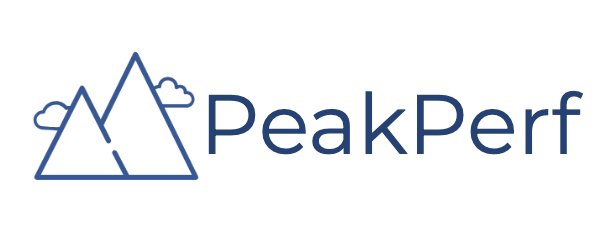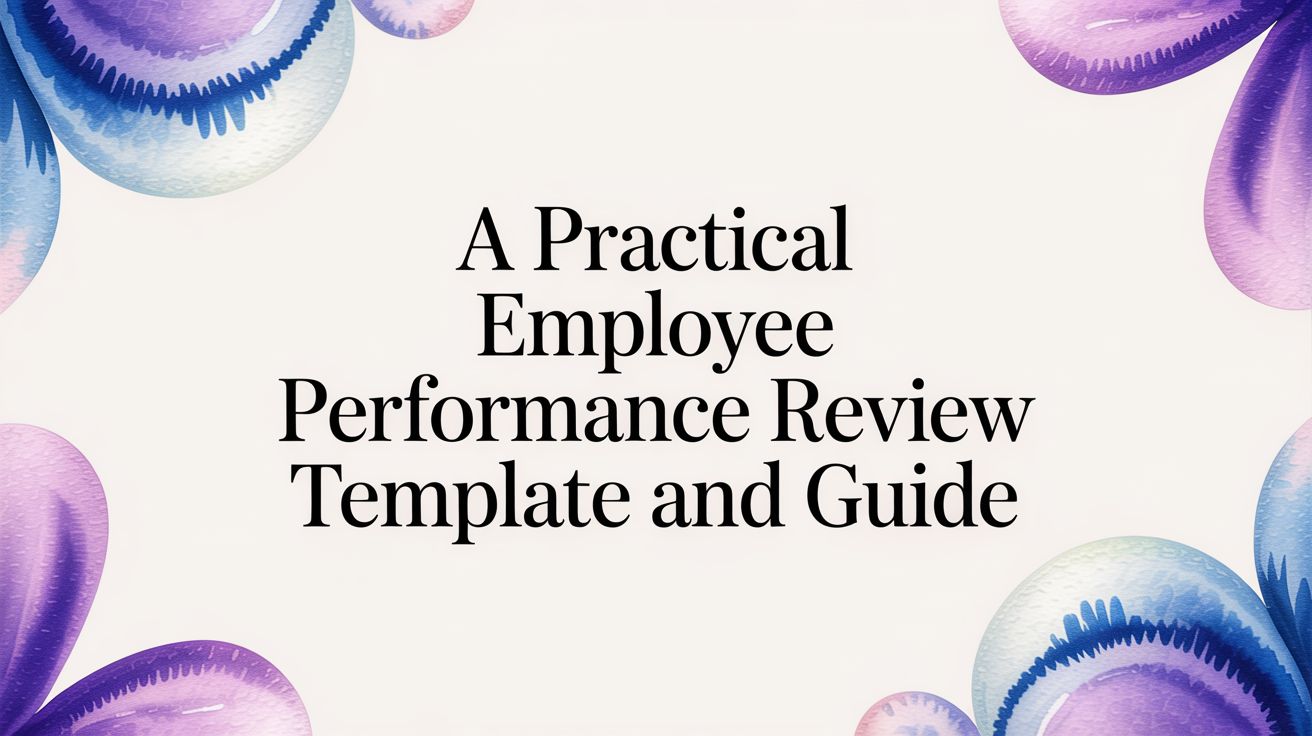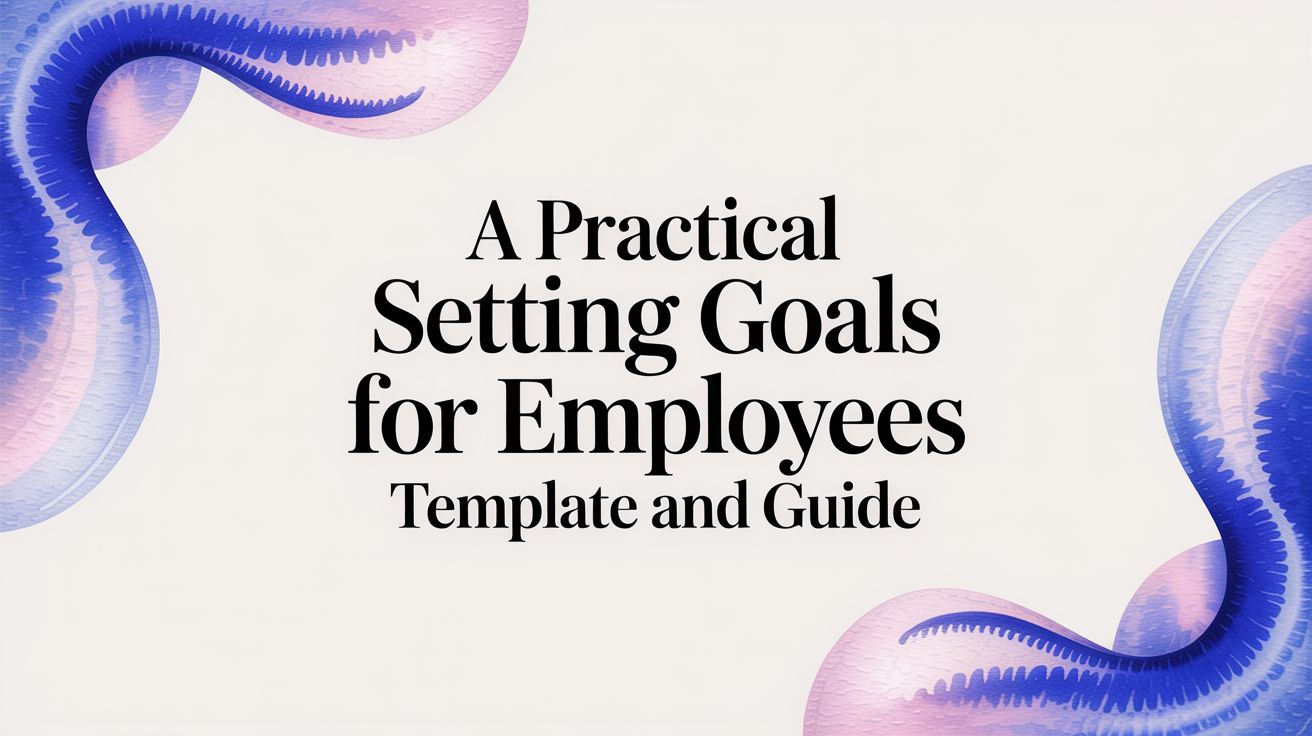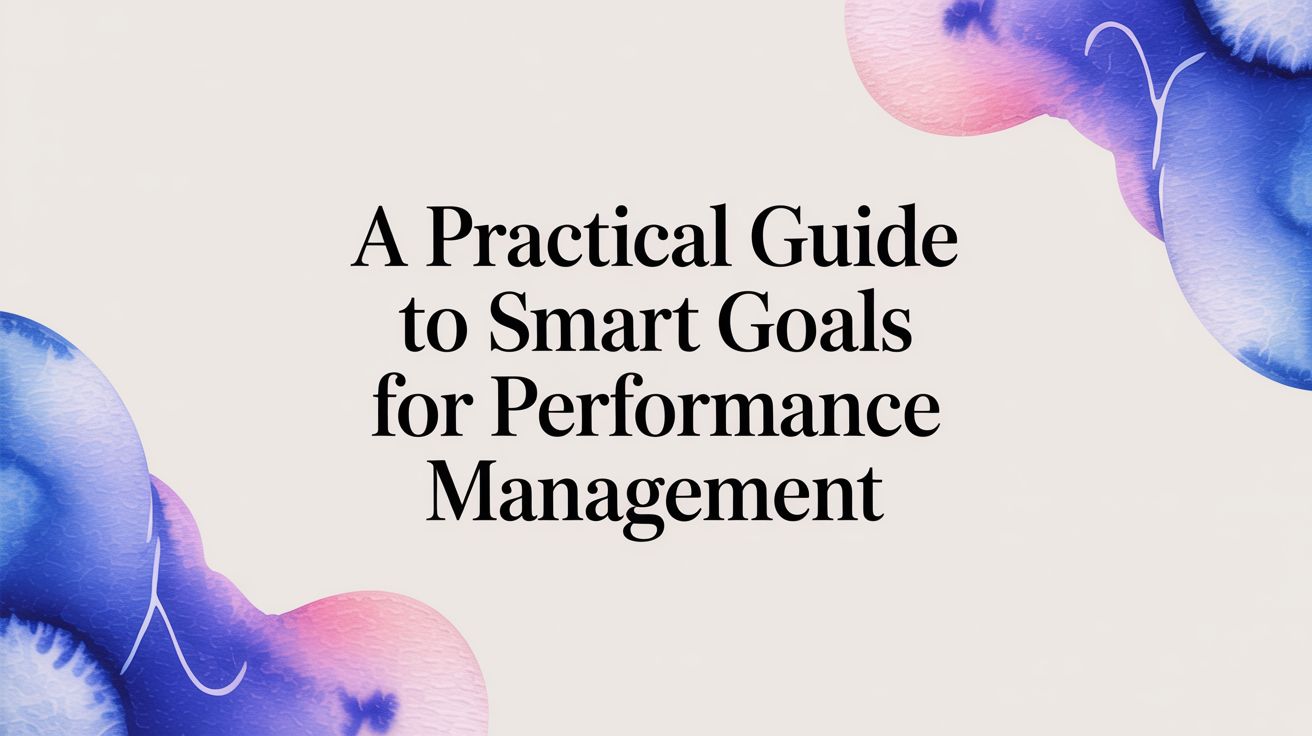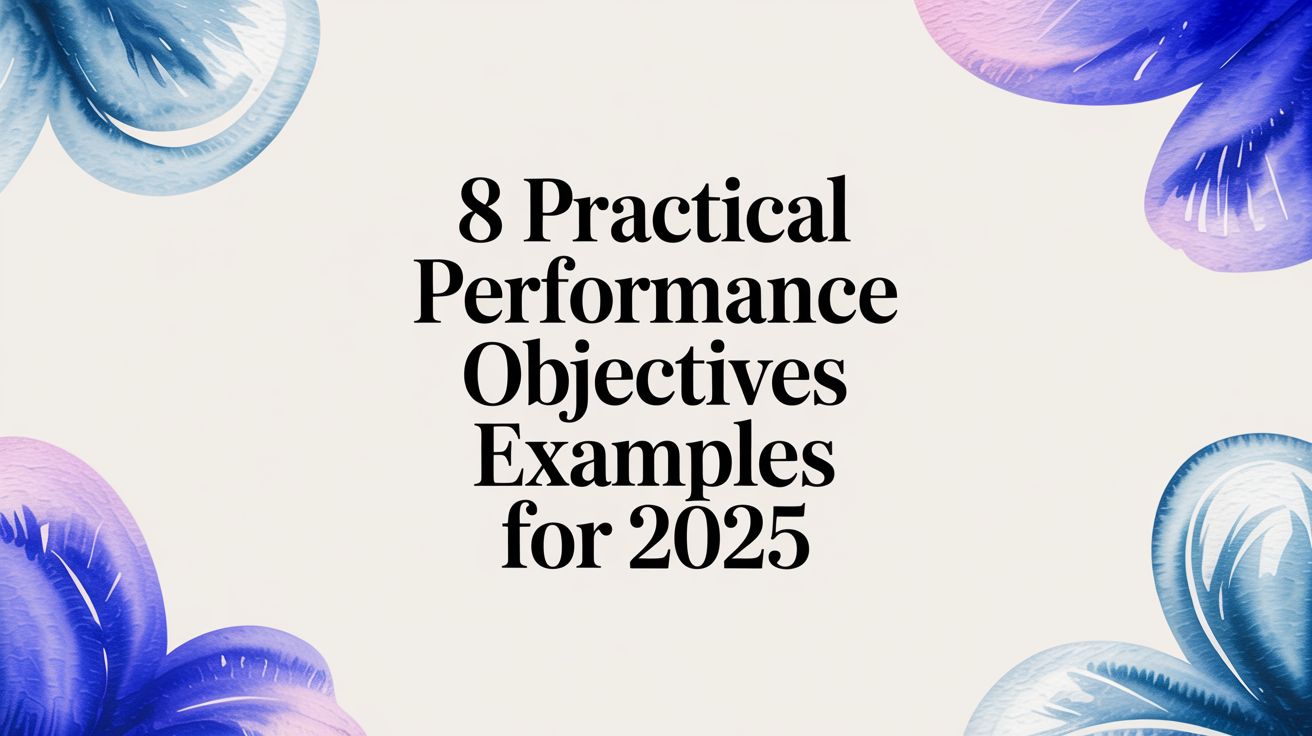10 Performance Management Best Practices for 2025
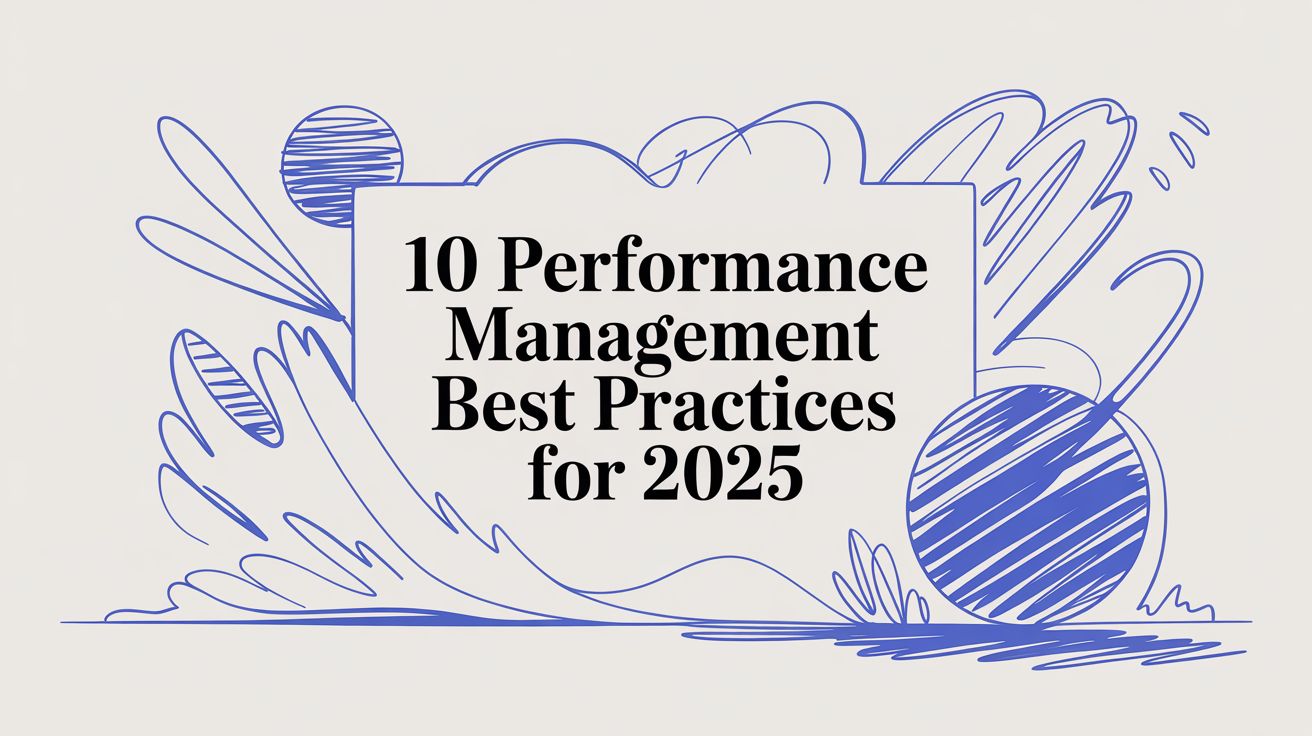
Effective performance management is a continuous process, not a once-a-year event. Your team’s success depends on clear goals, consistent feedback, and a firm commitment to development. Old methods of performance appraisal often fail to motivate employees or provide timely guidance. This leads to disengagement and missed opportunities. Modern approaches create a supportive and productive environment where people understand expectations and see how their work contributes to larger company objectives. This shift transforms performance discussions from dreaded obligations into valuable tools for growth and alignment.
This guide outlines 10 proven performance management best practices to move your team beyond the outdated annual review. Each one provides a structured framework for managers to lead with confidence and clarity. You will find practical steps, real-world examples, and specific scripts to help you and your team succeed. These strategies will help you build stronger relationships, address performance issues proactively, and foster a culture of continuous improvement.
Inside, you will learn to implement systems like Objectives and Key Results (OKRs) for transparent goal-setting and 360-Degree Feedback for comprehensive insights. We will cover the benefits of continuous feedback through effective 1-on-1 meetings and how to use data to make fair, objective decisions. You will also get actionable advice on competency-based evaluations, peer recognition programs, and agile performance management. Whether you are a new manager or an experienced leader, these techniques will equip you to inspire high performance and develop your team’s full potential.
1. Continuous Feedback and 1-on-1 Meetings
One of the most impactful performance management best practices is shifting from the outdated annual review to a model of continuous feedback. This approach replaces a single, high-pressure evaluation with an ongoing dialogue between you and your team members. The focus moves from a formal, once-a-year judgment to consistent coaching, real-time course correction, and immediate recognition. Companies like Adobe and Microsoft adopted this model to foster agility and employee growth.

This method centers on regular, predictable one-on-one meetings. These meetings create a dedicated space to discuss progress, remove obstacles, and align on expectations. Instead of saving feedback for a yearly summary, you address performance issues as they arise and celebrate achievements when they happen. This builds a culture of psychological safety and open communication. This prevents small problems from becoming significant ones.
How to Implement Continuous Feedback
To make this practice work, you need structure and consistency. Follow these steps to build a successful continuous feedback loop with your team.
- Schedule and Protect Time: Book recurring weekly or bi-weekly 30-minute one-on-one meetings with each direct report. Treat this time as non-negotiable to show you prioritize their development.
- Use a Shared Agenda: Create a simple, shared document for each employee’s one-on-one. Both of you should add agenda items beforehand. These items typically cover recent wins, current challenges, and upcoming priorities. This ensures the meeting is productive and employee-driven.
- Balance Recognition and Redirection: Use each meeting to provide both positive reinforcement for good work and constructive guidance for areas needing improvement. For more detailed strategies, review these effective methods for giving feedback to employees.
- Document Key Takeaways: End each meeting by summarizing action items and decisions. A brief, written record helps ensure accountability and tracks progress over time.
2. Objectives and Key Results (OKRs)
Another essential performance management best practice is implementing a goal-setting framework like Objectives and Key Results (OKRs). This methodology provides a simple, effective way to align individual, team, and company goals. OKRs define what you want to achieve (the Objective) and how you will measure progress toward that goal (the Key Results). Companies like Google and LinkedIn credit OKRs with driving their strategic alignment and growth.
This framework creates transparency and focus across the entire organization. An Objective is a qualitative, ambitious goal. Key Results are the specific, measurable outcomes that prove the objective has been met. By making these goals public, everyone understands how their individual contributions connect to the larger company mission. This clarity ensures that performance is directly tied to business impact. This moves beyond simple task completion.
How to Implement OKRs
To successfully integrate OKRs, you need a disciplined and transparent approach. Follow these steps to set up the framework for your team.
- Define Ambitious Objectives: Your objectives should be inspiring and challenging. For a quarter, define one to three high-level goals for your team that clearly support the organization’s strategic priorities.
- Create Measurable Key Results: For each objective, establish three to five specific, quantifiable Key Results. These should measure outcomes, not activities. For example, instead of “Launch new marketing campaign,” a Key Result would be “Increase new user sign-ups from marketing channels by 15%.”
- Separate OKRs from Compensation: Avoid tying OKR achievement directly to bonuses or raises. This separation encourages your team to set ambitious "stretch" goals and take calculated risks without fear of financial penalty if they fall slightly short.
- Track and Review Progress Regularly: OKRs are not a “set it and forget it” tool. Discuss progress during your weekly or bi-weekly one-on-ones. A formal review at the end of each quarter is also necessary to grade performance and set new OKRs for the next cycle.
3. 360-Degree Feedback
A traditional top-down review offers only one perspective. A more comprehensive performance management best practice is 360-degree feedback. This process gathers anonymous input from an employee's full circle of influence: their manager, peers, and direct reports. This method provides a balanced and holistic view of an individual's skills, behaviors, and impact on the organization. Companies like Deloitte and Microsoft use this approach to cultivate self-awareness and support leadership development.
This multidimensional feedback process moves beyond a single source of truth. The process uncovers blind spots and highlights strengths that might otherwise go unnoticed. When an employee receives consistent feedback from multiple sources about their communication or collaboration skills, the message is reinforced. This creates a strong catalyst for growth and professional development.
How to Implement 360-Degree Feedback
A successful 360-degree feedback process requires careful planning and a commitment to psychological safety. Follow these steps to introduce it effectively.
- Ensure Anonymity and Confidentiality: Use a trusted third-party tool or a secure internal system to collect responses. Guaranteeing that feedback is anonymous is critical for getting honest, constructive input.
- Train Participants: Provide clear instructions and training to all raters on how to give effective, behavior-based feedback. Focus on specific observations rather than personal opinions. This ensures the feedback is actionable. For more guidance, explore these essential management feedback examples.
- Use a Skilled Facilitator: Have a manager, HR business partner, or an external coach facilitate the feedback review session. A skilled facilitator helps the employee process the information constructively and prevents them from feeling overwhelmed or defensive.
- Focus on Development: Frame the entire process around growth, not evaluation. The goal is to create an actionable development plan based on the feedback. The goal is not to tie the results directly to compensation or promotion decisions.
4. Performance Management Systems and Software
To execute modern performance management best practices effectively, you need the right tools. Performance management systems are digital platforms that automate, streamline, and centralize all your performance-related activities. These software solutions move your processes out of spreadsheets and into an integrated environment for tracking goals, collecting feedback, and managing review cycles. Companies like Workday and SAP SuccessFactors offer robust systems that provide real-time visibility into performance across the entire organization.
These systems create a single source of truth for performance data. They connect continuous feedback, goal progress, and formal reviews in one place. This integration helps you make fairer, data-driven decisions about promotions, compensation, and development opportunities. Modern platforms like Lattice or 15Five are designed specifically to support continuous feedback and OKR methodologies. This design makes it easier to adopt these more agile approaches.
How to Implement a Performance Management System
Choosing and rolling out software requires a thoughtful strategy to ensure it supports your people, not your processes. Follow these steps for a successful implementation.
- Align Software with Strategy: Select a system that directly supports your organization’s performance philosophy. If you prioritize continuous feedback, choose a platform built for that purpose instead of one focused solely on annual reviews.
- Invest in Training and Change Management: A new tool requires new habits. Provide comprehensive training for all users, from individual contributors to senior leaders. You should communicate the benefits clearly to drive adoption.
- Customize Workflows: Do not force your company’s processes into a rigid, out-of-the-box template. Use the software’s customization features to configure workflows that match how your teams already work.
- Prioritize Integration: Ensure the system integrates smoothly with your existing HR tech stack, like your HRIS or payroll software. This prevents data silos and administrative headaches.
5. Competency-Based Performance Management
Another key performance management best practice is adopting a competency-based framework. This model evaluates employees on the demonstrated behaviors and skills required for their role. This moves beyond a sole focus on results. It assesses how work gets done by measuring critical skills, knowledge, and abilities. Companies like Shell and Accenture use comprehensive competency models to build well-rounded, capable teams.
This approach creates a clear roadmap for employee development. By defining what "good" looks like in terms of behavior, you provide a transparent standard for success. It helps identify specific skill gaps and create targeted development plans. This ensures that training efforts are directly aligned with both individual and organizational needs. This fosters a culture of continuous learning and skill improvement.
How to Implement Competency-Based Management
Integrating a competency framework requires a deliberate and structured process. Follow these steps to effectively implement this model for your team.
- Define Core Competencies: Work with HR and senior leaders to identify the key skills and behaviors essential for success in each role and for the organization. These might include communication, problem-solving, or leadership.
- Create Behavioral Indicators: For each competency, define specific, observable behaviors that demonstrate proficiency. For example, "problem-solving" could include behaviors like "analyzes data to identify root causes" and "proposes multiple viable solutions."
- Train Managers on Assessment: Equip your managers to assess employees against these competencies fairly and consistently. Provide training on how to observe behaviors and avoid common biases in evaluations.
- Link Competencies to Development: Use competency assessments to identify skill gaps and build personalized growth plans. If an employee struggles with a specific competency, this data can inform the structure of a performance improvement plan.
- Review and Update Regularly: Business needs change, so your competency models must adapt. Revisit and refine your framework annually to ensure it remains relevant to your strategic goals.
6. Balanced Scorecard Approach
Another effective performance management best practice is adopting the Balanced Scorecard (BSC) framework. This strategic planning and management system moves beyond traditional financial metrics. It gives you a more comprehensive view of business performance. It organizes performance measures across four key perspectives: financial, customer, internal business processes, and learning and growth. This ensures individual and team performance is directly tied to the organization's overarching strategic objectives.
The Balanced Scorecard, developed by Robert Kaplan and David Norton, helps translate your company’s vision into a set of actionable performance indicators. For example, hospitality leaders like Marriott and Hilton used this model to align global operations with strategic goals. They ensured that metrics like customer satisfaction and employee training directly support financial outcomes. This holistic approach helps you communicate how an individual’s daily work contributes to the company's long-term success. This makes performance management more meaningful.
How to Implement a Balanced Scorecard Approach
Implementing a Balanced Scorecard requires connecting strategy to execution. Follow these steps to apply this framework to your team’s performance management.
- Identify Key Strategic Objectives: For each of the four perspectives (Financial, Customer, Internal Processes, Learning & Growth), define what your team needs to achieve to support the company’s mission.
- Select a Limited Number of Metrics: Choose 3-5 critical metrics for each perspective. Too many metrics will dilute focus. Include a mix of leading indicators (predictive of future success) and lagging indicators (summarizing past performance).
- Establish Clear Cause-and-Effect Links: Ensure your team understands how improving a metric in one area, like employee training (Learning & Growth), impacts another, such as customer satisfaction (Customer).
- Cascade Scorecards and Communicate Clearly: Adapt the scorecard for different roles within your team. Ensure each person has clear, relevant goals. Regularly communicate progress against the scorecard to keep everyone aligned and motivated.
7. Peer Recognition and Gamification
Another strong performance management best practice involves leveraging your team’s collective spirit through peer-to-peer recognition and gamification. This approach shifts some of the responsibility for motivation from managers to the entire team. It creates a system where colleagues can acknowledge and reward each other’s contributions in real-time. By incorporating game-like elements such as points, badges, and leaderboards, you turn positive reinforcement into an engaging and interactive experience.
This method fosters a culture of appreciation and reinforces company values organically. When employees are empowered to celebrate their teammates' successes, it strengthens relationships and improves morale. Companies like Salesforce and platforms like Bonusly have shown how these systems drive engagement by making recognition visible and frequent. The goal is to build a positive feedback loop where desired behaviors are consistently seen, celebrated, and replicated across the organization.
How to Implement Peer Recognition and Gamification
A successful program requires clear structure and genuine employee buy-in. Follow these steps to introduce this practice effectively.
- Establish Clear Guidelines: Define what constitutes meaningful recognition. Link the criteria directly to your company’s core values, specific goals, or desired behaviors. This ensures the praise is purposeful and not arbitrary.
- Choose the Right Platform: Use a dedicated tool or a simple internal system, like a specific Slack channel. The key is to make recognition visible, easy to give, and accessible to everyone on the team.
- Keep it Voluntary and Fun: Participation should be encouraged, not mandatory. The system’s success depends on authentic appreciation. Over-structuring it or forcing engagement can make it feel like another corporate task.
- Analyze Recognition Patterns: Use the data from your program as a management tool. Look for employees who consistently receive praise for their collaboration or problem-solving skills. This helps you identify informal leaders and high-impact contributors who might otherwise be overlooked.
8. Agile and Iterative Performance Management
Borrowing from software development, an agile and iterative approach to performance management swaps rigid annual cycles for a more fluid, responsive system. This practice emphasizes short work cycles, or sprints, followed by reflection and adaptation. It is built for environments where priorities shift quickly. This makes it one of the most effective performance management best practices for dynamic and innovative teams. Companies like Spotify and Atlassian championed this model to align performance with rapid business changes.
This method keeps your team adaptable and focused on continuous improvement. Instead of waiting a full year to assess outcomes, you use frequent check-ins, team retrospectives, and real-time adjustments. This creates a culture of learning and resilience. Teams can quickly pivot based on new information or changing project requirements. It turns performance management into an active, ongoing part of the workflow, not a separate administrative task.
How to Implement Agile Performance Management
To adopt this flexible approach, you need to establish a clear rhythm and new routines. Follow these steps to integrate agile principles into your performance process.
- Establish Clear Sprints: Define short, consistent work cycles, typically two to four weeks long. At the start of each sprint, set clear, achievable goals for the team and for individuals. This creates a predictable cadence for work and review.
- Conduct Regular Retrospectives: At the end of each sprint, hold a team retrospective to discuss what went well, what challenges arose, and what can be improved. Focus these meetings on process and collaboration. Keep them action-oriented.
- Use Daily Stand-ups: Implement brief, daily check-in meetings. Each team member shares what they worked on yesterday, what they plan to do today, and any obstacles they face. This provides real-time visibility and helps unblock issues quickly.
- Train Managers in Agile Coaching: Equip managers with the skills to coach in an agile environment. This means focusing on asking strong questions, facilitating team problem-solving, and providing timely, context-specific feedback.
9. Strengths-Based Performance Management
A transformative performance management best practice is to focus on what your team members do best. Strengths-based performance management shifts the conversation from correcting weaknesses to identifying and amplifying an employee’s natural talents. This approach builds on what people do exceptionally well. It aligns their roles and goals with their core strengths to drive engagement and superior results. Companies like Google and Adobe integrated strengths-focused coaching and feedback into their development models.
This method recognizes that investing in a person's inherent talents often yields a greater return than trying to fix their shortcomings. When you help employees use their strengths every day, they become more confident, productive, and innovative. This builds a positive and empowering work environment where team members feel valued for their unique contributions. This leads to higher retention and overall team effectiveness.
How to Implement Strengths-Based Performance Management
To apply this practice effectively, you need a clear process for identifying, discussing, and leveraging employee strengths.
- Conduct Strengths Assessments: Use validated tools like Gallup's CliftonStrengths or the VIA Character Strengths survey to give employees a clear language for their talents. These assessments provide an objective starting point for development conversations.
- Discuss Strengths Openly: In one-on-one meetings, discuss the assessment results. Ask questions like, “When do you feel most energized at work?” and “Which of these strengths do you get to use most often?” This helps connect their talents to daily tasks.
- Align Roles and Responsibilities: Where possible, adjust job responsibilities to better align with an individual’s strengths. If someone has a talent for strategic thinking, assign them to more planning-oriented projects.
- Build Complementary Partnerships: Create teams where members’ strengths complement one another. Pair an employee strong in ideation with someone who excels at execution to create a balanced partnership. This is a key part of strategic team design.
- Frame Feedback Around Strengths: When giving constructive feedback, frame it through the lens of their strengths. For example, say, "Your strength in building relationships is excellent. How can you apply that skill to improve collaboration with the engineering team?"
10. Data-Driven and Analytics-Based Performance Management
Another essential performance management best practice is adopting an evidence-based approach using data and analytics. This method moves beyond subjective opinions by using people analytics, performance metrics, and HR data to inform decisions. It helps identify patterns, predict outcomes, and refine your management strategies. Companies like Amazon and Google use extensive data analytics to improve manager effectiveness and make objective talent decisions.

This practice combines quantitative data with qualitative human judgment for a more balanced and fair process. Instead of relying solely on gut feelings, you can use dashboards and reports to spot high performers, identify skill gaps, and understand team-wide trends. This data-informed perspective supports more objective conversations about performance and development. It reduces the impact of unconscious bias.
How to Implement Data-Driven Performance Management
To effectively use data, you must be intentional about its collection, interpretation, and application. Follow these steps to integrate analytics into your performance management cycle.
- Define Key Metrics: Identify what success looks like for each role. Focus on a few meaningful metrics, such as project completion rates, customer satisfaction scores, or sales targets, instead of tracking everything.
- Use Data to Support, Not Replace, Judgment: Present data as a conversation starter during one-on-ones, not as a final verdict. Use it to ask better questions and explore the context behind the numbers. For example, say, "I see your project completion time has increased. What roadblocks are you facing?"
- Ensure Transparency and Ethical Use: Be open with your team about what data you are collecting and how you are using it. This builds trust and ensures the process is perceived as fair. Always address potential issues like algorithmic bias and data quality.
- Combine with Qualitative Feedback: Numbers rarely tell the whole story. Pair quantitative data with qualitative insights from 360-degree feedback, peer reviews, and your own observations for a complete performance picture.
Top 10 Performance Management Practices Comparison
| Approach | 🔄 Complexity | ⚡ Resources (time/cost) | 📊 Expected outcomes | 💡 Ideal use cases | ⭐ Key advantages |
|---|---|---|---|---|---|
| Continuous Feedback and 1-on-1 Meetings | Moderate — ongoing scheduling and manager skill required | High time commitment for managers; low tech cost | Faster issue resolution; continuous development; higher engagement | Coaching-oriented teams; knowledge work; retention focus | Strengthens relationships; real-time coaching and recognition |
| Objectives and Key Results (OKRs) | High — cross-level alignment and cadence planning | Moderate — planning effort and tracking tools | Strategic alignment; measurable, ambitious outcomes | Growth-stage companies; product/strategy-driven teams | Drives focus, transparency and accountability |
| 360-Degree Feedback | High — multi-rater coordination, anonymity and analysis | High — survey platforms, facilitator time, data processing | Holistic behavioral insights; identifies blind spots | Leadership development; succession planning; promotions | Reduces single-rater bias; increases self-awareness |
| Performance Management Systems & Software | High — implementation, integrations, change management | High — license, IT, training; scales after rollout | Centralized workflows; real-time dashboards; analytics | Large enterprises; distributed or remote workforces | Automates processes; enables data-driven decisions and consistency |
| Competency-Based Performance Management | High — design and maintain competency models | Moderate–High — SME involvement, training, assessment tools | Clear expectations; targeted development; succession readiness | Regulated/professional services; role-based career paths | Clarifies role requirements; supports development and mobility |
| Balanced Scorecard Approach | High — strategic translation and cascaded metrics | Moderate–High — planning, data collection and analytics | Strategy-to-execution alignment; balanced short/long-term view | Strategy-driven organizations; multi-divisional enterprises | Links strategy to measurable actions across perspectives |
| Peer Recognition and Gamification | Low–Moderate — platform setup and governance | Low–Moderate — platform cost, program management | Increased morale and engagement; visible appreciation | Customer-facing teams; sales; younger workforce | Improves engagement; encourages positive peer reinforcement |
| Agile and Iterative Performance Management | Moderate — requires agile practices and cultural change | Moderate — frequent rituals and manager engagement | Rapid adaptability; continuous improvement and learning | Product teams, startups, R&D and fast-moving projects | Enables quick course correction and responsiveness |
| Strengths-Based Performance Management | Moderate — assessments and role redesign effort | Moderate — assessment tools, coaching, role adjustments | Better role fit; higher engagement and retention | Talent-development focused orgs; retention strategies | Leverages strengths to increase motivation and productivity |
| Data-Driven & Analytics-Based Performance Management | High — data integration, modeling and governance | High — analytics talent, platforms and maintenance | Objective insights; predictive interventions; trend identification | Organizations with mature HR data and analytics capability | Evidence-based decisions; predictive talent strategies and reduced bias |
Putting Your Performance Plan into Action
You have explored a comprehensive set of performance management best practices. These strategies move beyond the outdated annual review. They create a dynamic, supportive, and data-informed system for employee growth. We covered the foundational importance of continuous feedback through structured one on ones. We also examined goal-setting frameworks like OKRs and the holistic view provided by 360-degree feedback.
From technology-driven solutions to human-centric approaches like strengths-based management, each method offers a unique tool for your leadership toolkit. You learned how to integrate competency models, balance scorecards, and peer recognition to build a well-rounded program. The key is understanding that effective performance management is not a one-size-fits-all solution. It is a tailored approach that reflects your company’s culture, goals, and the specific needs of your team.
Your First Steps to Implementation
Transforming your approach can feel like a significant task, but you can start small. The goal is to build momentum through consistent, focused effort. Do not attempt to implement all ten strategies at once. Instead, choose one or two that address your most pressing challenges.
Consider this simple roadmap to get started:
- Start with Feedback: If you do nothing else, establish a consistent cadence for one on one meetings. This practice is the bedrock of modern performance management. It builds trust, opens communication channels, and makes feedback a normal part of your work week.
- Define Success with Goals: Once your feedback loop is strong, introduce a clear goal-setting framework like OKRs. This step gives your team a shared understanding of priorities and connects their individual contributions to the larger organizational mission.
- Measure and Adapt: Select a few key metrics to track progress. Are employees more engaged? Is goal attainment improving? Use this data to refine your process and decide which practice to introduce next, such as peer recognition or a more formal competency model.
The Value of a Modern Approach
Adopting these performance management best practices yields direct benefits. You create a culture of transparency and accountability where employees feel seen and valued. This leads to higher engagement, improved retention, and stronger overall business results. When you invest in your team's development, you are investing in the long-term success of your organization.
A well-executed performance management system clarifies expectations, removes roadblocks, and empowers individuals to achieve their full potential. It turns managers from simple evaluators into effective coaches. By focusing on continuous improvement and developmental conversations, you build a resilient, high-performing team capable of navigating any challenge. Your commitment to these principles is the single most impactful way to drive both individual growth and collective success.
Ready to put these performance management best practices into action with less effort? PeakPerf provides guided frameworks, conversation starters, and simple tracking for one on ones, goals, and feedback. Prepare for meaningful discussions in minutes and build a high-performing team with a tool designed for modern managers.
